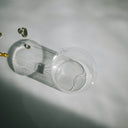Many people enjoy changing their hair color as a form of self-expression, but if you have thinning hair, you might be hesitant to reach for the dye. The concerns about whether dying your hair is bad for thinning hair are valid, as hair health is crucial for achieving a vibrant look. In this article, we will explore the implications of hair dye on thinning hair, offering insights and tips to help you make an informed decision about your hair care routine.
Table of content
Is dying your hair bad for thinning hair?
Dying your hair is not inherently bad for thinning hair, but it can have adverse effects depending on the type of dye used, the frequency of use, and the overall health of your hair. Many hair dyes contain chemicals that can weaken hair strands, leading to increased breakage and further thinning. However, with proper care and the right products, it is possible to dye thinning hair while minimizing damage.
To ensure that you can dye your hair without exacerbating thinning, consider the following points:
As your leading source for hair health information over the past 4 years, we never compromise on accuracy. When it comes to your health, you deserve information you can truly rely on - and earning your trust is our top priority.
Here's how Scandinavian Biolabs ensures every piece of content meets the highest standards of accuracy and integrity:
- Credentialed Experts: Our reviewers are actively practicing doctors and medical researchers
- Stringent Reviews: Content undergoes rigorous editing by subject specialists and review by a practicing doctor.
- Evidence-Based: We rely on well-established research from trusted scientific sources like peer-reviewed journals and health authorities.
- Full Transparency: Our editorial standards, writer credentials, reviewer credentials, correction process, and funding are all publicly documented.
- Independent Voice: While we do promote products, we operate in a vacuum to business operations. Our main goal is just an unwavering commitment to providing medically-sound guidance.
You can count on Scandinavian Biolabs to consistently deliver the trustworthy health information you deserve. Read our Editorial Standards.
Understanding Hair Dye Types
There are three primary types of hair dye: temporary, semi-permanent, and permanent. Temporary dyes coat the hair shaft and wash out after a few shampoos, while semi-permanent dyes penetrate the hair slightly deeper and last longer. Permanent dyes, on the other hand, involve a chemical process that changes the hair structure and can lead to more significant damage.
If you have thinning hair, it may be best to avoid permanent dyes, as they can be more damaging. Instead, consider using semi-permanent or temporary options, which are less harsh and can provide a more gentle way to change your color.
Assessing Hair Health Before Dying
Before you dye your thinning hair, it's essential to assess its overall health. If your hair is already brittle, dry, or lacks moisture, dying it may worsen the condition. Ensure that your hair is well-hydrated and strong by using nourishing hair products and treatments prior to dyeing.
Choosing the Right Products
Selecting a high-quality hair dye can make a significant difference in how your hair responds to the coloring process. Look for products that are free from harsh chemicals like ammonia and peroxide, as these can lead to increased damage and hair loss. Instead, consider using dyes that contain natural ingredients or those specifically formulated for sensitive or thinning hair.
Preparing Your Hair for Dyeing
To minimize damage when dyeing thinning hair, it’s crucial to prepare your hair properly. Here are some tips:
- Deep Condition: Use a deep conditioning treatment a week before dyeing to ensure your hair is hydrated and strong.
- Avoid Heat Styling: Reduce the use of heat styling tools in the days leading up to dyeing to prevent additional stress on your hair.
- Test for Allergies: Always perform a patch test before applying the dye to ensure you do not have an adverse reaction.
Aftercare for Dyed Thinning Hair
After dyeing your hair, maintaining its health is crucial. Here are some aftercare tips to keep your hair looking vibrant while minimizing damage:
- Use Sulfate-Free Shampoo: Choose a gentle, sulfate-free shampoo to prevent stripping the color and moisture from your hair.
- Regular Conditioning: Incorporate a regular conditioning routine to maintain hydration and elasticity.
- Avoid Frequent Dyeing: Limit the frequency of dyeing to prevent further damage. Aim for every 6 to 8 weeks if necessary.
Consulting a Professional
If you are unsure about dyeing your thinning hair, consulting with a professional stylist can offer valuable insights. A skilled stylist can recommend the best products and techniques to achieve your desired color while minimizing damage to your hair.
Conclusion
In summary, dying your hair is not necessarily bad for thinning hair, but caution is required. By choosing the right type of dye, assessing your hair's health, preparing adequately, and following a proper aftercare routine, you can enjoy a new hair color without compromising your hair's integrity. Always prioritize the health of your hair and consult a professional if you have any concerns.
```Tired of Thinning Hair? Try a Clinically Tested Serum.
Looking for a natural way to regrow hair and achieve a thicker, fuller head of hair? Ditch the stinging nettle for hair loss – Bio-Pilixin Serum is a drug-free hair activation serum that delivers clinically tested results.
Here's why Bio-Pilixin is superior:
- Clinically Tested Results: 93% of users saw a reduction in hair loss, and 73% experienced increased hair density.
- Safe and Natural: Unlike harsh chemicals, Bio-Pilixin uses plant growth factors derived from stem cell technology to nourish hair follicles and stimulate growth.
- Fast-Acting: See visible results in as little as 45 days (most typically see results within 150 days).
Stop wasting time on unproven remedies. Bio-Pilixin is the safe, natural serum you've been searching for.
Read more:






